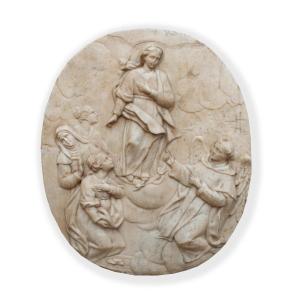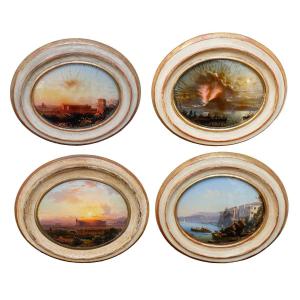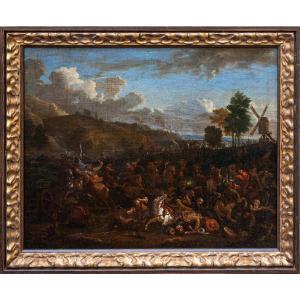Crucifixion with saints
Oil on canvas, cm 76 x 60
With frame cm 95 x 79
Critical Note Professor Giuseppe Sava
The crucifixion described here belongs to the Lombard school of the seventeenth century. Against a background of cold tones and dark, stormy landscape, you can see the buildings of a city that should be identified with Jerusalem. On the right a hilly fifth bare and earthy tones covers the rest of the urban view, thus attracting the eye to the foreground where at the foot of the cross the Magdalene and a holy warrior, in armor and clothes seventeenth century, are kneeling. If the first one looks at Jesus crying and languishing, the second one shows the extreme sacrifice with his hand and turns his gaze to the spectator. The latter, holding the palm of martyrdom and wearing a wide crimson cloak, typical of the saints warriors, reveals his identity thanks to the iron mace placed on the rock, on his right. The iconographic detail allows you to recognize San Defendente, a Roman military man who lived in Thebes in the third century and was martyred under the emperor Maximian. The name to be pronounced for the small Crucifixion is that of Francesco Zucco, a painter to whom Count Francesco Maria Tassi (1793) reserved an entire biography. Born in Bergamo around 1570 (the exact year is not yet supported by documents), soon inclined"to the study of painting", he was "sent by the Father to Cremona in the celebrated school of the Campi". The authorship of the work can be deduced from the habit of immortalizing the kneeling figures on a block of stone, as in this case and as in the altarpiece in San Pancrazio in Carobbio degli Angeli, dated 1608, in which the Virgin with the Child is venerated by Saint Bernard and Saint Catherine of Siena. The rapid touches of light also affect some points in the background landscape and allow to better distinguish the profile of buildings. The tangencies with Giovan Battista Moroni and with the Bergamo school are well evident, although the naturalistic reading gives way to a figure almost heraldic of painting, so that the figures, rather unpolished and devoid of life, touch an almost unreal consistency: is the result of the interweaving of the culture of the post-Trientine image, purged and rigoristic, with the instances of the last season of Mannerism, that of Cremona matrix. In this sense we can mention the first masters of the Zucco: the Campi brothers, especially Giulio, in whose Crucifixion in Santa Maria della Passione is found the Magdalene embraced at the cross and the strong chiaroscuro contrasts. Francesco Zucco himself makes a larger version for the church of San Lorenzo in Bergamo. The same approach is found in the canvas of the same subject by Giovan Paolo Cavagna, preserved at the Pinacoteca Tosio Martinengo in Brescia. For the periodization we must place the work between the second and third decade of the seventeenth century, at a time of full maturity for the artist from Bergamo.










































 Le Magazine de PROANTIC
Le Magazine de PROANTIC TRÉSORS Magazine
TRÉSORS Magazine Rivista Artiquariato
Rivista Artiquariato